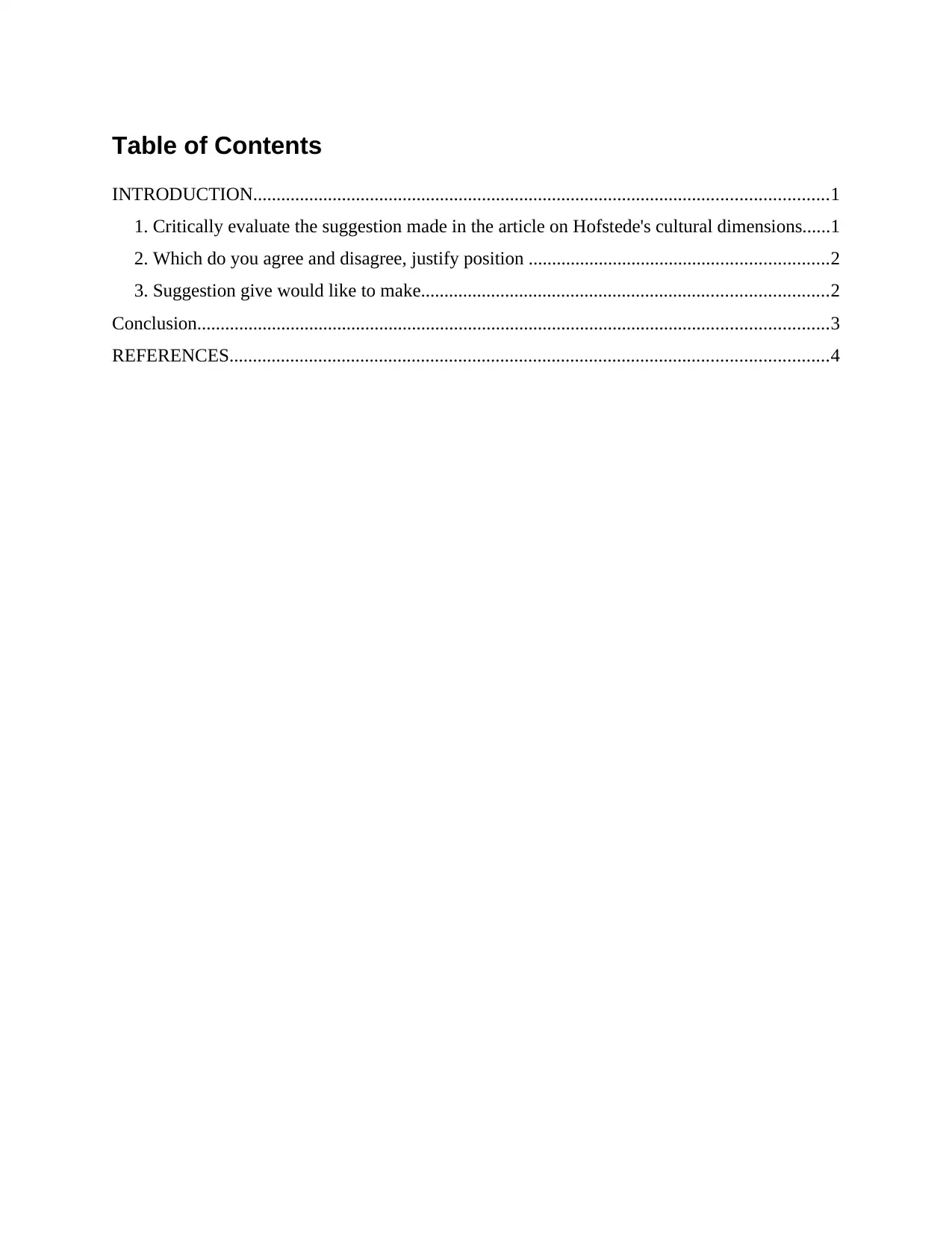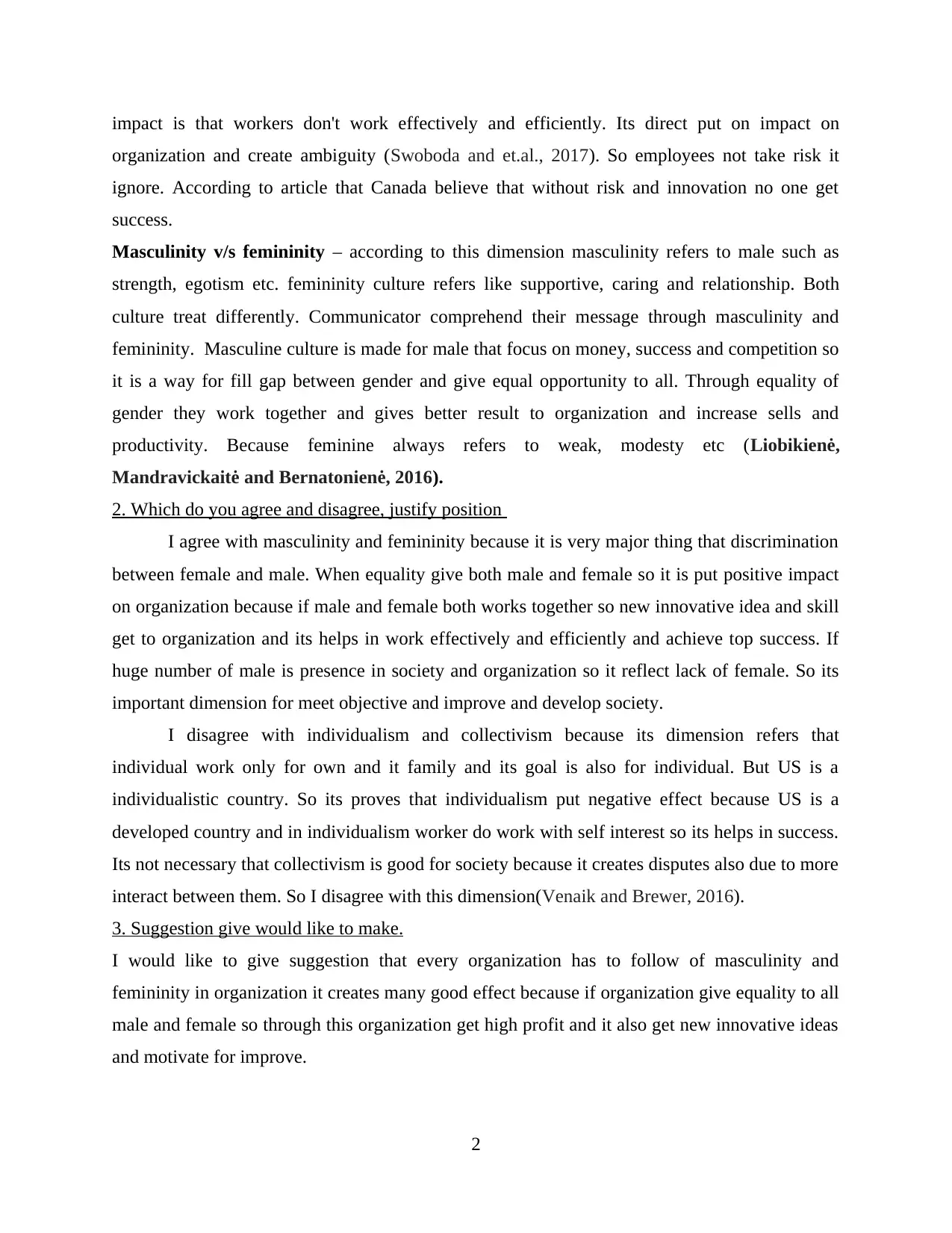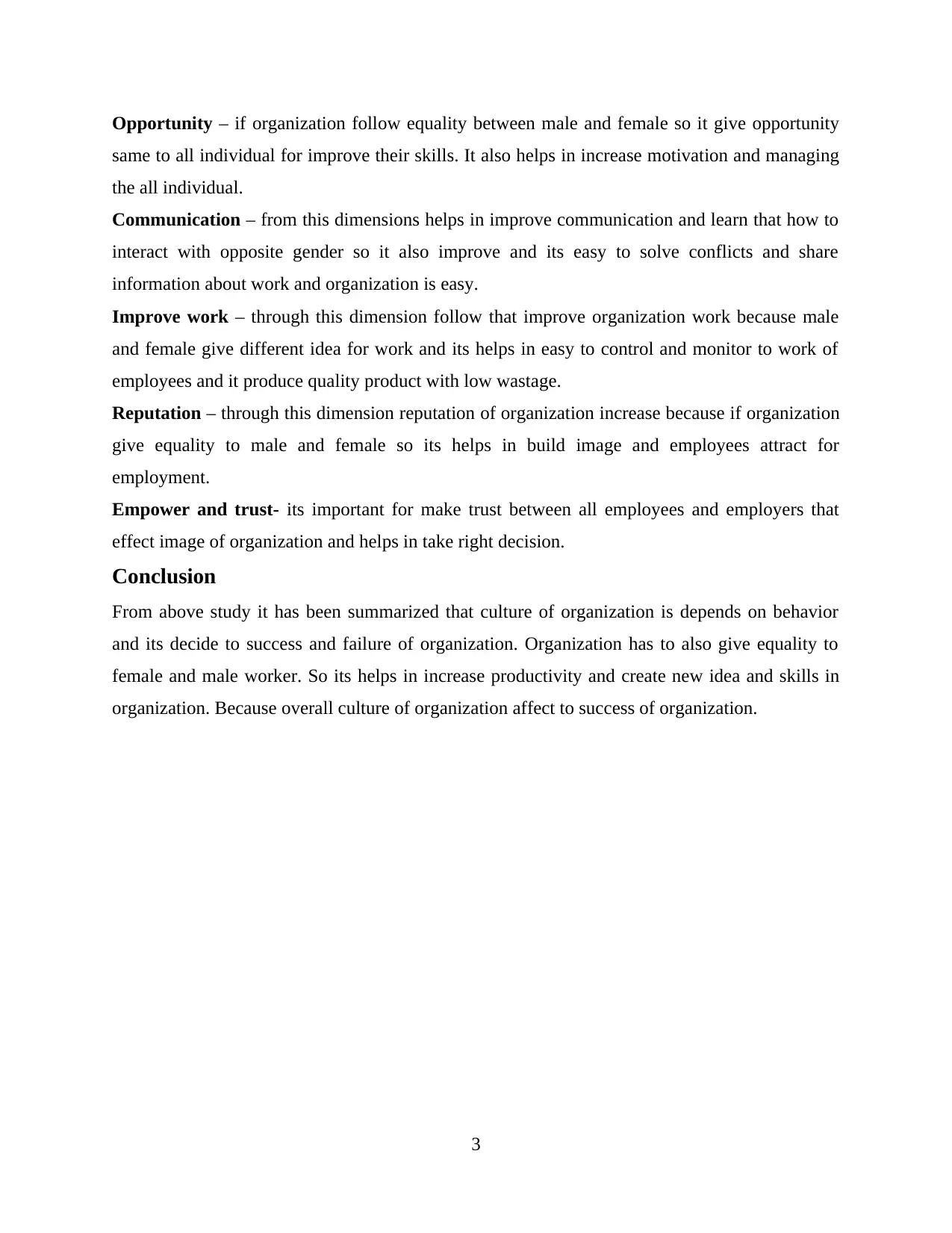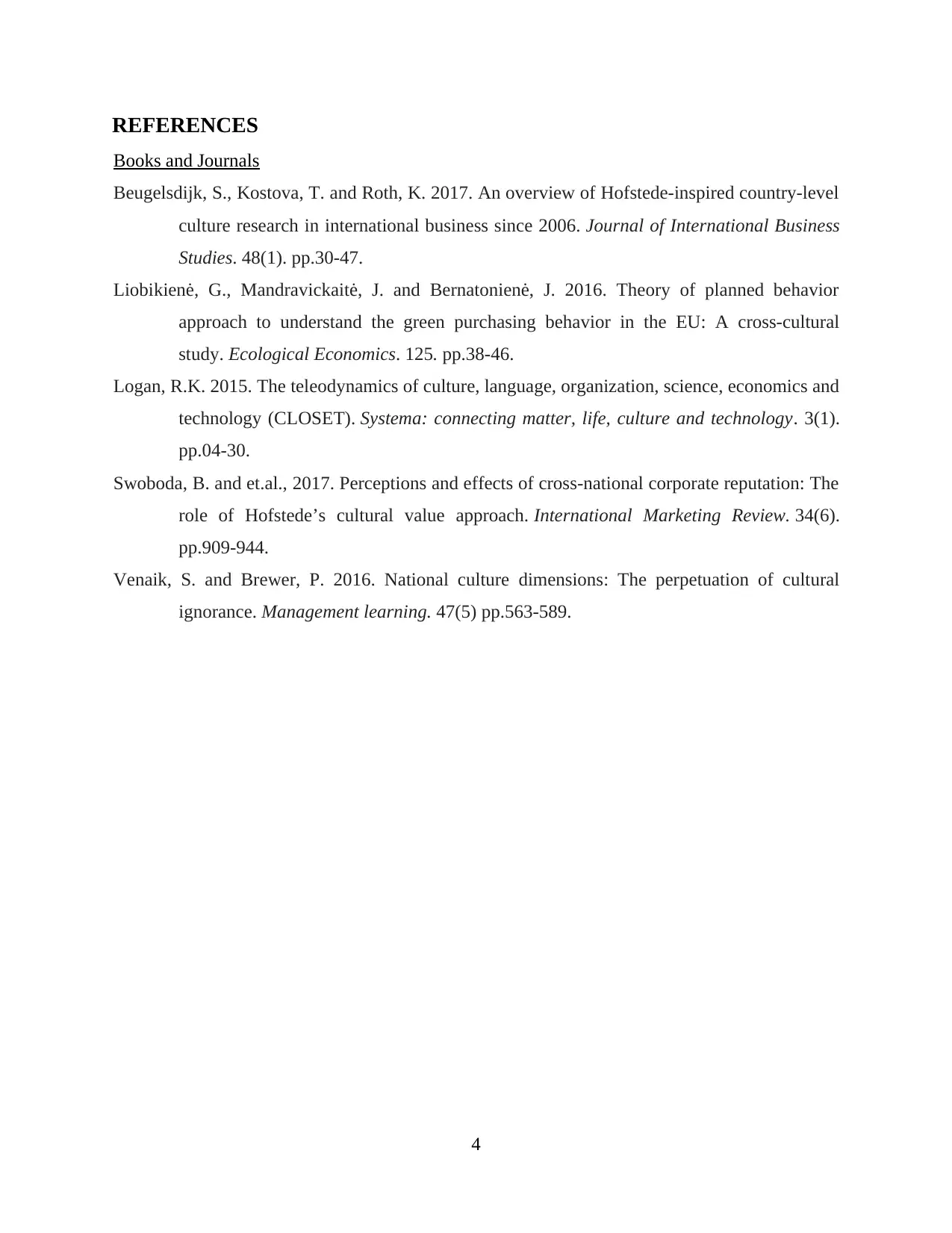Essay: Evaluating Hofstede's Cultural Dimensions in Business Context
VerifiedAdded on 2020/12/30
|6
|1344
|578
Essay
AI Summary
This essay provides an in-depth analysis of Hofstede's cultural dimensions and their impact on business environments. It begins with an introduction to business culture and Hofstede's framework, outlining key dimensions such as individualism/collectivism, power distance, uncertainty avoidance, and masculinity/femininity. The essay critically evaluates the suggestions made in the provided article, discussing the positive and negative effects of each dimension on organizational behavior and performance. It then presents the author's agreement and disagreement with specific dimensions, providing justifications based on the provided research and examples. Finally, the essay offers suggestions for organizations, emphasizing the importance of gender equality, opportunity, improved communication, enhanced work processes, and a strong organizational reputation. The conclusion summarizes the significance of understanding and adapting to cultural dimensions for business success.

Individual
essays
essays
Paraphrase This Document
Need a fresh take? Get an instant paraphrase of this document with our AI Paraphraser

Table of Contents
INTRODUCTION...........................................................................................................................1
1. Critically evaluate the suggestion made in the article on Hofstede's cultural dimensions......1
2. Which do you agree and disagree, justify position ................................................................2
3. Suggestion give would like to make.......................................................................................2
Conclusion.......................................................................................................................................3
REFERENCES................................................................................................................................4
INTRODUCTION...........................................................................................................................1
1. Critically evaluate the suggestion made in the article on Hofstede's cultural dimensions......1
2. Which do you agree and disagree, justify position ................................................................2
3. Suggestion give would like to make.......................................................................................2
Conclusion.......................................................................................................................................3
REFERENCES................................................................................................................................4

INTRODUCTION
Business culture give directions for thinking and it has five elements like rituals, symbols, beliefs
and thoughts. Hofstede's culture dimensions describes that society's culture effect on their
members so it is frame work of cross culture. This culture shows that individualism and
collectivism are refers to one people and group of people that work together and its effect is
positive. This report will cover Hofstede's cultural dimensions that includes individual and
collective, power distance and uncertainty and its include that what is suitable and positive and
negative effect of dimensions and suggestions also.
1. Critically evaluate the suggestion made in the article on Hofstede's cultural dimensions.
This article shows that culture of organization always influence business. It give four dimensions
that impact business environment like individualism/collectivism, power distance, uncertainty
and masculinity/femininity (Beugelsdijk, Kostova and Roth, 2017).
Individualism / collectivism – this dimensions describes that relationship between individual
and group are self oriented or not. In individualism put effect on organization because individual
act only for own, for their family and according to their choice and self interest. In this individual
set goal only for own. But in collectivism culture exist group and its goal is also collective so
they work for achieve goal in group because in this culture workers do hard work. Collectivism
also helps in make strong bond and create and establish good relationship so in any conflict and
problem it helps to each other. So both dimensions use for analyse culture and behaviours of
individual and group.
Power distance - it is also a dimension that measure inequality in the organization with lower
class of individuals. Because in organization inequality is very major thing between superiors
and subordinates. It include that power distributed unequally and it received from customers.
Two type of power distance culture present that higher and lower. So it present hierarchy is not
present in proper and systematic manner in the organization. According to this article UK has
higher and lower power distance elements and US also adopt management in business
environment. So through this it gives equal power to all subordinates so it helps in solve conflicts
and treat equally (Logan, 2015).
Uncertainty – according to this article uncertainty and ambiguity avoid in organization and its
affect to culture of organization. Its avoidance impact positively in organization and employees
and workers of organization work together and follow all rules and regulation and its negative
1
Business culture give directions for thinking and it has five elements like rituals, symbols, beliefs
and thoughts. Hofstede's culture dimensions describes that society's culture effect on their
members so it is frame work of cross culture. This culture shows that individualism and
collectivism are refers to one people and group of people that work together and its effect is
positive. This report will cover Hofstede's cultural dimensions that includes individual and
collective, power distance and uncertainty and its include that what is suitable and positive and
negative effect of dimensions and suggestions also.
1. Critically evaluate the suggestion made in the article on Hofstede's cultural dimensions.
This article shows that culture of organization always influence business. It give four dimensions
that impact business environment like individualism/collectivism, power distance, uncertainty
and masculinity/femininity (Beugelsdijk, Kostova and Roth, 2017).
Individualism / collectivism – this dimensions describes that relationship between individual
and group are self oriented or not. In individualism put effect on organization because individual
act only for own, for their family and according to their choice and self interest. In this individual
set goal only for own. But in collectivism culture exist group and its goal is also collective so
they work for achieve goal in group because in this culture workers do hard work. Collectivism
also helps in make strong bond and create and establish good relationship so in any conflict and
problem it helps to each other. So both dimensions use for analyse culture and behaviours of
individual and group.
Power distance - it is also a dimension that measure inequality in the organization with lower
class of individuals. Because in organization inequality is very major thing between superiors
and subordinates. It include that power distributed unequally and it received from customers.
Two type of power distance culture present that higher and lower. So it present hierarchy is not
present in proper and systematic manner in the organization. According to this article UK has
higher and lower power distance elements and US also adopt management in business
environment. So through this it gives equal power to all subordinates so it helps in solve conflicts
and treat equally (Logan, 2015).
Uncertainty – according to this article uncertainty and ambiguity avoid in organization and its
affect to culture of organization. Its avoidance impact positively in organization and employees
and workers of organization work together and follow all rules and regulation and its negative
1
⊘ This is a preview!⊘
Do you want full access?
Subscribe today to unlock all pages.

Trusted by 1+ million students worldwide

impact is that workers don't work effectively and efficiently. Its direct put on impact on
organization and create ambiguity (Swoboda and et.al., 2017). So employees not take risk it
ignore. According to article that Canada believe that without risk and innovation no one get
success.
Masculinity v/s femininity – according to this dimension masculinity refers to male such as
strength, egotism etc. femininity culture refers like supportive, caring and relationship. Both
culture treat differently. Communicator comprehend their message through masculinity and
femininity. Masculine culture is made for male that focus on money, success and competition so
it is a way for fill gap between gender and give equal opportunity to all. Through equality of
gender they work together and gives better result to organization and increase sells and
productivity. Because feminine always refers to weak, modesty etc (Liobikienė,
Mandravickaitė and Bernatonienė, 2016).
2. Which do you agree and disagree, justify position
I agree with masculinity and femininity because it is very major thing that discrimination
between female and male. When equality give both male and female so it is put positive impact
on organization because if male and female both works together so new innovative idea and skill
get to organization and its helps in work effectively and efficiently and achieve top success. If
huge number of male is presence in society and organization so it reflect lack of female. So its
important dimension for meet objective and improve and develop society.
I disagree with individualism and collectivism because its dimension refers that
individual work only for own and it family and its goal is also for individual. But US is a
individualistic country. So its proves that individualism put negative effect because US is a
developed country and in individualism worker do work with self interest so its helps in success.
Its not necessary that collectivism is good for society because it creates disputes also due to more
interact between them. So I disagree with this dimension(Venaik and Brewer, 2016).
3. Suggestion give would like to make.
I would like to give suggestion that every organization has to follow of masculinity and
femininity in organization it creates many good effect because if organization give equality to all
male and female so through this organization get high profit and it also get new innovative ideas
and motivate for improve.
2
organization and create ambiguity (Swoboda and et.al., 2017). So employees not take risk it
ignore. According to article that Canada believe that without risk and innovation no one get
success.
Masculinity v/s femininity – according to this dimension masculinity refers to male such as
strength, egotism etc. femininity culture refers like supportive, caring and relationship. Both
culture treat differently. Communicator comprehend their message through masculinity and
femininity. Masculine culture is made for male that focus on money, success and competition so
it is a way for fill gap between gender and give equal opportunity to all. Through equality of
gender they work together and gives better result to organization and increase sells and
productivity. Because feminine always refers to weak, modesty etc (Liobikienė,
Mandravickaitė and Bernatonienė, 2016).
2. Which do you agree and disagree, justify position
I agree with masculinity and femininity because it is very major thing that discrimination
between female and male. When equality give both male and female so it is put positive impact
on organization because if male and female both works together so new innovative idea and skill
get to organization and its helps in work effectively and efficiently and achieve top success. If
huge number of male is presence in society and organization so it reflect lack of female. So its
important dimension for meet objective and improve and develop society.
I disagree with individualism and collectivism because its dimension refers that
individual work only for own and it family and its goal is also for individual. But US is a
individualistic country. So its proves that individualism put negative effect because US is a
developed country and in individualism worker do work with self interest so its helps in success.
Its not necessary that collectivism is good for society because it creates disputes also due to more
interact between them. So I disagree with this dimension(Venaik and Brewer, 2016).
3. Suggestion give would like to make.
I would like to give suggestion that every organization has to follow of masculinity and
femininity in organization it creates many good effect because if organization give equality to all
male and female so through this organization get high profit and it also get new innovative ideas
and motivate for improve.
2
Paraphrase This Document
Need a fresh take? Get an instant paraphrase of this document with our AI Paraphraser

Opportunity – if organization follow equality between male and female so it give opportunity
same to all individual for improve their skills. It also helps in increase motivation and managing
the all individual.
Communication – from this dimensions helps in improve communication and learn that how to
interact with opposite gender so it also improve and its easy to solve conflicts and share
information about work and organization is easy.
Improve work – through this dimension follow that improve organization work because male
and female give different idea for work and its helps in easy to control and monitor to work of
employees and it produce quality product with low wastage.
Reputation – through this dimension reputation of organization increase because if organization
give equality to male and female so its helps in build image and employees attract for
employment.
Empower and trust- its important for make trust between all employees and employers that
effect image of organization and helps in take right decision.
Conclusion
From above study it has been summarized that culture of organization is depends on behavior
and its decide to success and failure of organization. Organization has to also give equality to
female and male worker. So its helps in increase productivity and create new idea and skills in
organization. Because overall culture of organization affect to success of organization.
3
same to all individual for improve their skills. It also helps in increase motivation and managing
the all individual.
Communication – from this dimensions helps in improve communication and learn that how to
interact with opposite gender so it also improve and its easy to solve conflicts and share
information about work and organization is easy.
Improve work – through this dimension follow that improve organization work because male
and female give different idea for work and its helps in easy to control and monitor to work of
employees and it produce quality product with low wastage.
Reputation – through this dimension reputation of organization increase because if organization
give equality to male and female so its helps in build image and employees attract for
employment.
Empower and trust- its important for make trust between all employees and employers that
effect image of organization and helps in take right decision.
Conclusion
From above study it has been summarized that culture of organization is depends on behavior
and its decide to success and failure of organization. Organization has to also give equality to
female and male worker. So its helps in increase productivity and create new idea and skills in
organization. Because overall culture of organization affect to success of organization.
3

REFERENCES
Books and Journals
Beugelsdijk, S., Kostova, T. and Roth, K. 2017. An overview of Hofstede-inspired country-level
culture research in international business since 2006. Journal of International Business
Studies. 48(1). pp.30-47.
Liobikienė, G., Mandravickaitė, J. and Bernatonienė, J. 2016. Theory of planned behavior
approach to understand the green purchasing behavior in the EU: A cross-cultural
study. Ecological Economics. 125. pp.38-46.
Logan, R.K. 2015. The teleodynamics of culture, language, organization, science, economics and
technology (CLOSET). Systema: connecting matter, life, culture and technology. 3(1).
pp.04-30.
Swoboda, B. and et.al., 2017. Perceptions and effects of cross-national corporate reputation: The
role of Hofstede’s cultural value approach. International Marketing Review. 34(6).
pp.909-944.
Venaik, S. and Brewer, P. 2016. National culture dimensions: The perpetuation of cultural
ignorance. Management learning. 47(5) pp.563-589.
4
Books and Journals
Beugelsdijk, S., Kostova, T. and Roth, K. 2017. An overview of Hofstede-inspired country-level
culture research in international business since 2006. Journal of International Business
Studies. 48(1). pp.30-47.
Liobikienė, G., Mandravickaitė, J. and Bernatonienė, J. 2016. Theory of planned behavior
approach to understand the green purchasing behavior in the EU: A cross-cultural
study. Ecological Economics. 125. pp.38-46.
Logan, R.K. 2015. The teleodynamics of culture, language, organization, science, economics and
technology (CLOSET). Systema: connecting matter, life, culture and technology. 3(1).
pp.04-30.
Swoboda, B. and et.al., 2017. Perceptions and effects of cross-national corporate reputation: The
role of Hofstede’s cultural value approach. International Marketing Review. 34(6).
pp.909-944.
Venaik, S. and Brewer, P. 2016. National culture dimensions: The perpetuation of cultural
ignorance. Management learning. 47(5) pp.563-589.
4
⊘ This is a preview!⊘
Do you want full access?
Subscribe today to unlock all pages.

Trusted by 1+ million students worldwide
1 out of 6
Related Documents
Your All-in-One AI-Powered Toolkit for Academic Success.
+13062052269
info@desklib.com
Available 24*7 on WhatsApp / Email
![[object Object]](/_next/static/media/star-bottom.7253800d.svg)
Unlock your academic potential
Copyright © 2020–2026 A2Z Services. All Rights Reserved. Developed and managed by ZUCOL.




